The September square is definitely the “funkiest” of the squares for this year – and also the most challenging! This square is the 9th square in the interlocking tiles set. These squares use interlocking crochet in the round to create totally unique and wow-worthy designs. This square is an explosion of rectangles. Give it a try! You can see all 12 squares in the Interlocking Tiles set, plus get information on how I joined the squares and made a cool interlocking crochet border here at the main Interlocking Tiles Blanket page.
*Disclosure: Some of the links in this post are affiliate links, which means if you click on them and make a purchase I may, at no additional cost to you, earn a commission. Read full disclosure here.

You can get the free pattern below, or you can purchase a printable PDF copy of this pattern from Ravelry or Etsy using these links!
Supplies
You can use any weight yarn and appropriate hook for these squares, though it will affect the finished size. For reference, my two samples were made in a Worsted or an Aran weight, both with an H hook, and the Aran ended up almost a full inch larger than the worsted. Here’s what I used:
- WeCrochet’s Wool of the Andes Worsted, Gull and Shire Heather, up to 30g each color
- Lovecrafts’ Paintbox Simply Aran in Mustard Yellow, Midnight Blue, and Stormy Gray
- Size H crochet hook – I love these Odyssey hooks from Furls Crochet!
- Stitch Markers – Seriously, at least 1 stitch marker, preferably 2.
- Yarn/Tapestry Needle
Stitch Abbreviations
- ch chain
- st(s) stitch(es)
- ss slip stitch
- sc single crochet
- dc double crochet
- blsc back loop single crochet
- fdc front double crochet
- bdc back double crochet
- fc front corner
- bc back corner
- fsplitc front split corner
- bsplitc back split corner
Pattern Notes
This square uses interlocking crochet in the round. (This technique is also known as interwoven, intermeshing, or double filet crochet). In interlocking crochet, every dc has a ch1 between it and the next dc. Corner stitches will have a ch4 between dc’s.
Except for the last row, each color only ever works into stitches of its own color. This effectively forms two meshes. The meshes are woven around each other as you work by changing whether you work stitches from the front of the work or the back of the work.
For an introduction to interlocking crochet, you can see this tutorial, though it is worked in rows rather than in the round.
There is also a complete video tutorial for this specific square (scroll down) in case you prefer video instruction. Each round in the instructions below also has a note telling what time in the video that round starts.
It is very important as you work to make sure that you are skipping the dc’s of the opposite color rows – 2dcs of the same color will always have a dc of the opposite color worked between them.
I recommend that instead of making your turn ch at the start of the next row, you make it at the end of the previous row so that you can more easily place stitch markers and make sure your starting chains are in the correct location, either in the front or the back of the work (this is noted in the instructions). Placing a stitch marker in the loop that would go on your hook when not in use will help to make sure you don’t accidentally unwind your work when not using that color.
Ch4’s at the start of a row count as either fdc or bdc (they count as the dc and the ch1)
There is a chart at the end of the PDF for you to use. There are two versions – one with letters written on to identify front or back stitches, with row markings in bold every other row, and one that is blank.
In my example, color A is blue or yellow, and color B is gray.
Special Stitches
Front Double Crochet (fdc): Working in front of the other color, double crochet into the dc on the same color row below, then ch1.
Back Double Crochet (bdc): Working behind the other color, double crochet into the dc on the same color row below, then ch1.
Front Corner (fc): Working in front of the other color, work (dc, ch4, dc, ch1) into the ch4 space of the same color row below.
Back Corner (bc): Working behind the other color, work (dc, ch4, dc, ch1) into the ch4 space of the same color row below.
Front Split Corner (fsplitc): Working into the ch4 space of the same color row below, work fdc, ch4, bdc. This is the same as a regular corner, except the first dc is worked from the front, and the second dc is worked from the back instead of both being worked from the front or back.
Back Split Corner (bsplitc): Working into the ch4 space of the same color row below, work bdc, ch4, fdc. This is the same as a regular corner, except the first dc is worked from the back, and the second dc is worked from the front instead of both being worked from the front or back.
September Square Video Tutorial
How to Make the September Interlocking Crochet Square
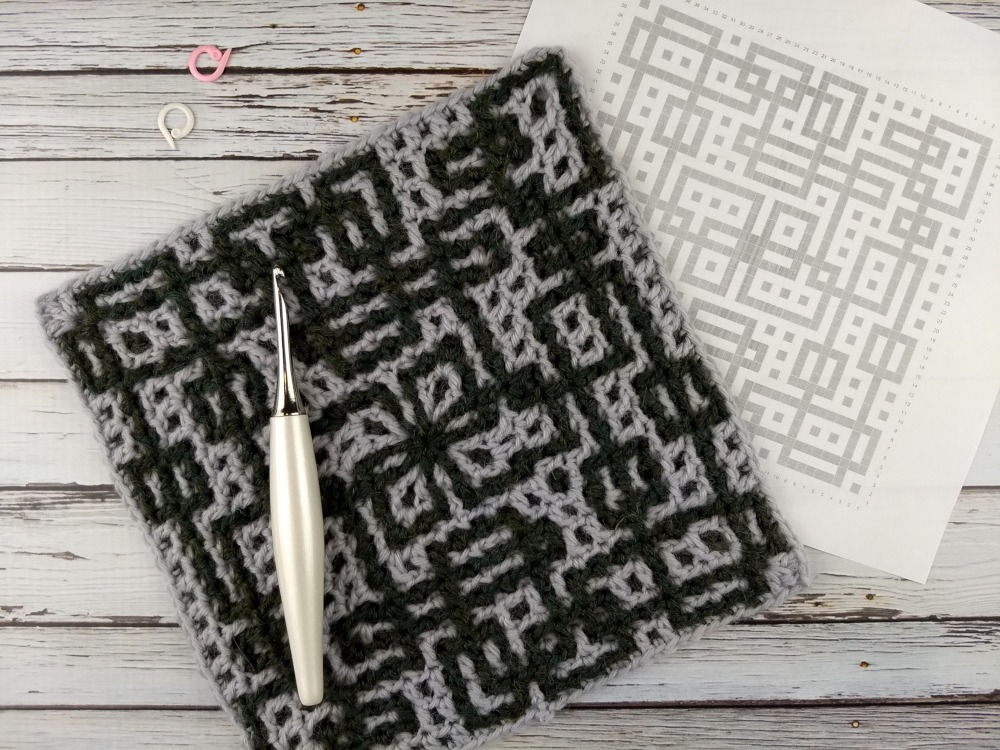
If you like to work with charts, you can download two different versions of this chart. The first version is a blank, color-only chart. The second one has f or b written on each stitch to designate which type of stitch you are doing, as well as having every other row marked in bold to help you keep your place.
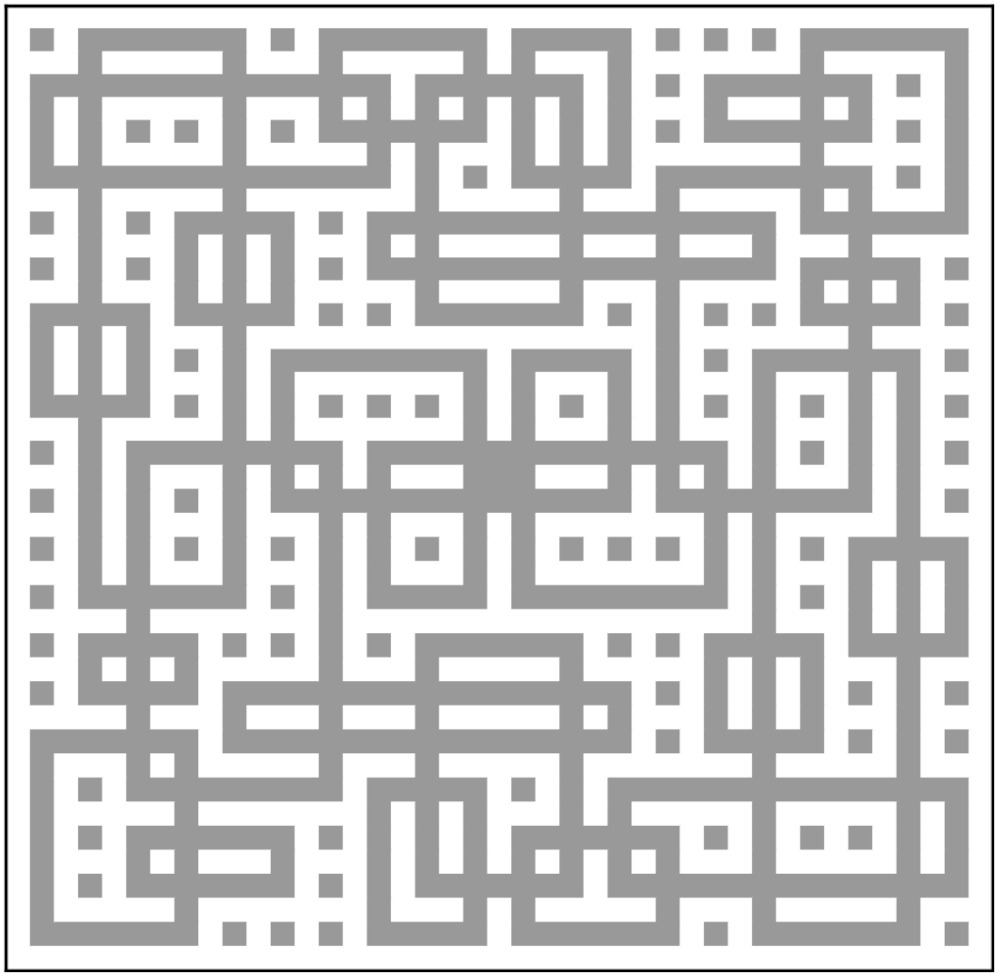
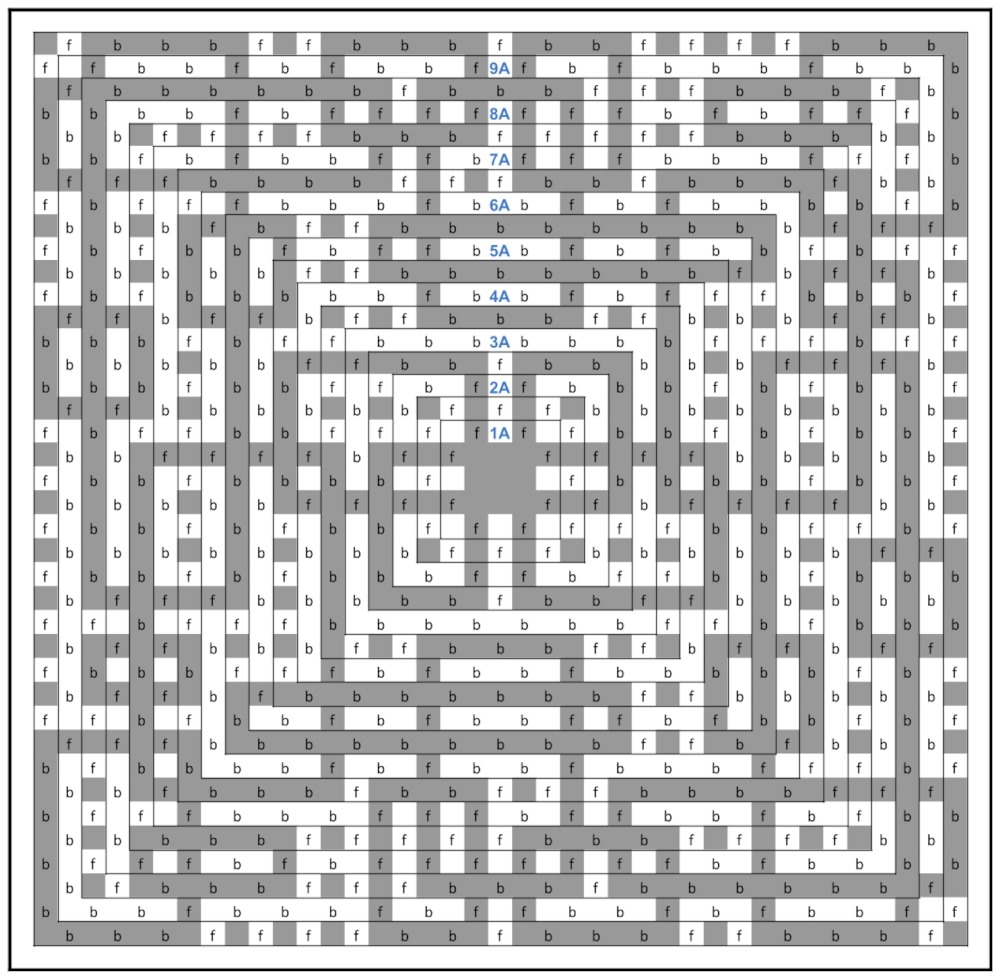
0/1A (set up rounds) [Video 0:00]
With color A, make a magic ring (or ch3 and join to form a ring). In the ring, ch7 (counts as first dc and ch4), dc, (ch1, dc, ch4, dc) 3 times, ch1, join to the third st of starting ch. Ch4, place stitch marker. (8dc and four ch4 spaces for corners).
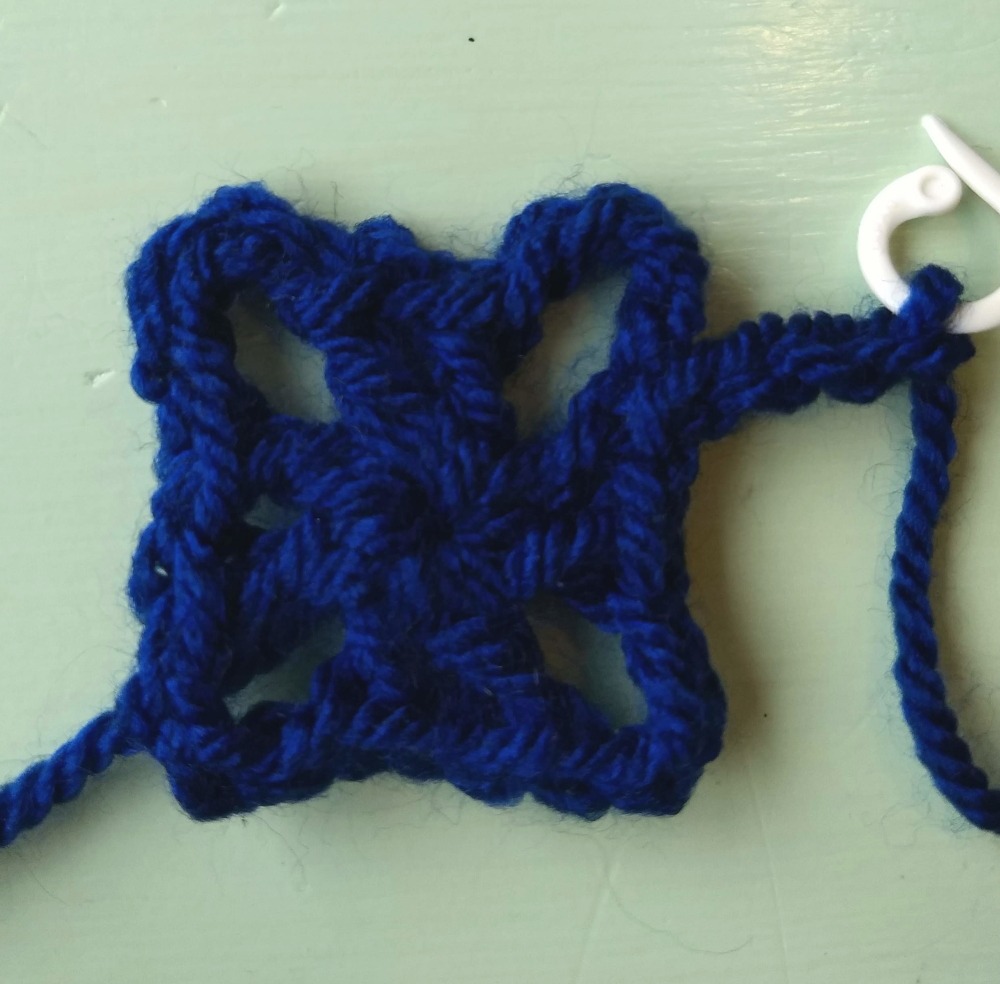
With color B, ch8, join to form a ring, then ch4.
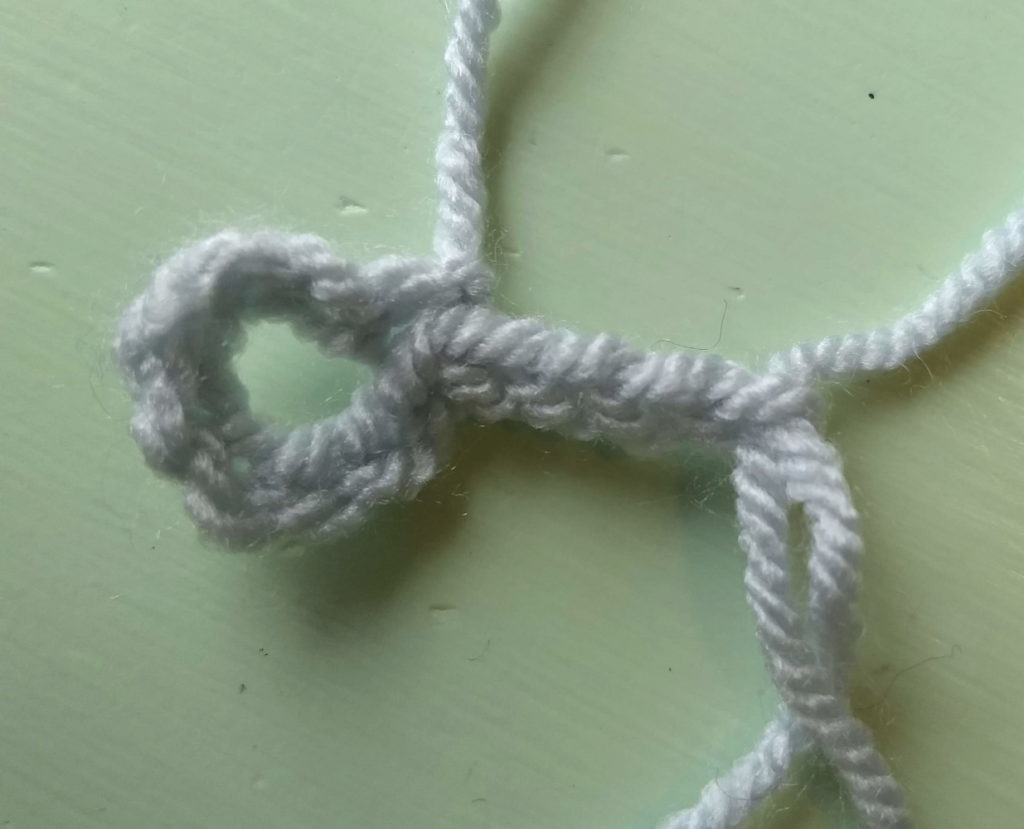
Starting from the front of your work, Insert the B color ring between the two A color dc’s, just to the right of the working yarn of A color.
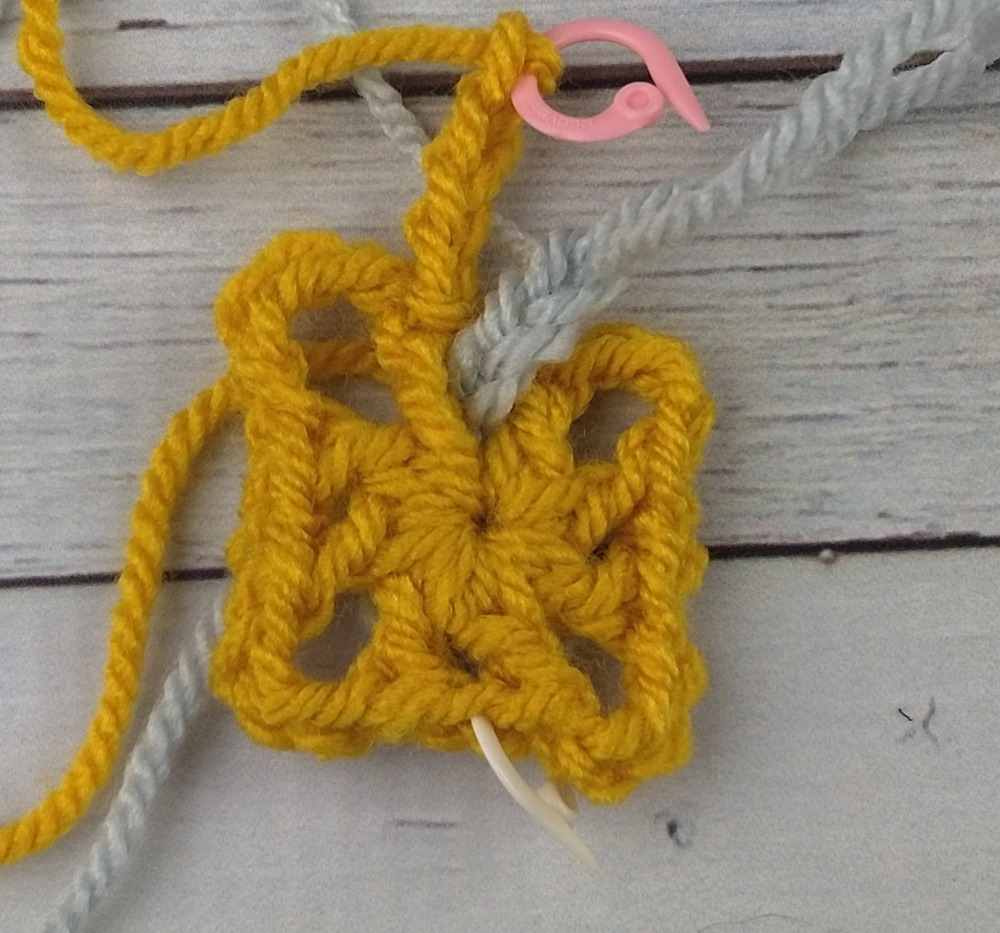
Notice how the working yarn for color B is placed just to the right of the working yarn for color A (this dc will be between the two side dc’s of color A), and the color B ring is behind the A color stitches. If desired, use a stitch marker to temporarily hold the B color ring in place.
Round 1B [Video 5:15]
[place working yarn of color A to the front] Working with color B, in ring, fc, (fdc, fc) three times, join to third st of starting ch. Ch4, place a stitch marker. (12dc)
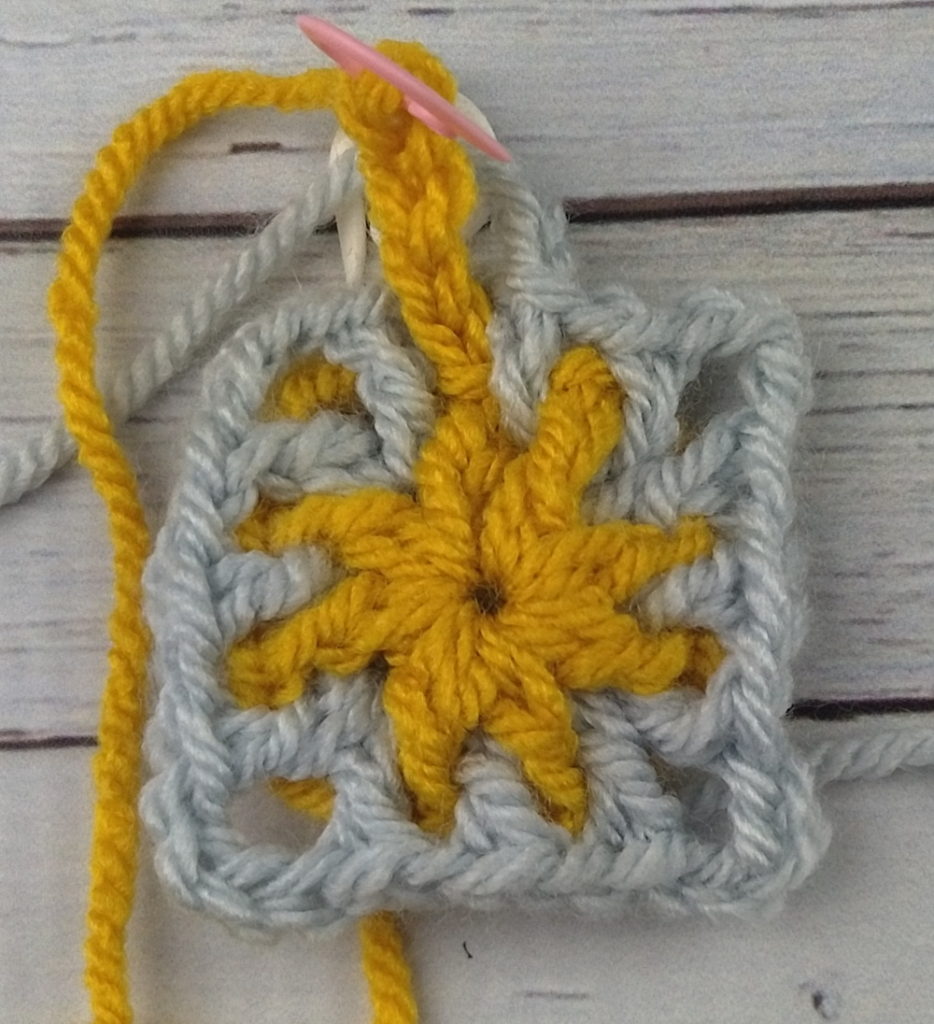
2A [Video 9:51]
[place color B in front] With A, bc, (fdc 2, bc) three times, fdc, join to 3rd st of starting ch. Ch4, place a stitch marker. (16dc)
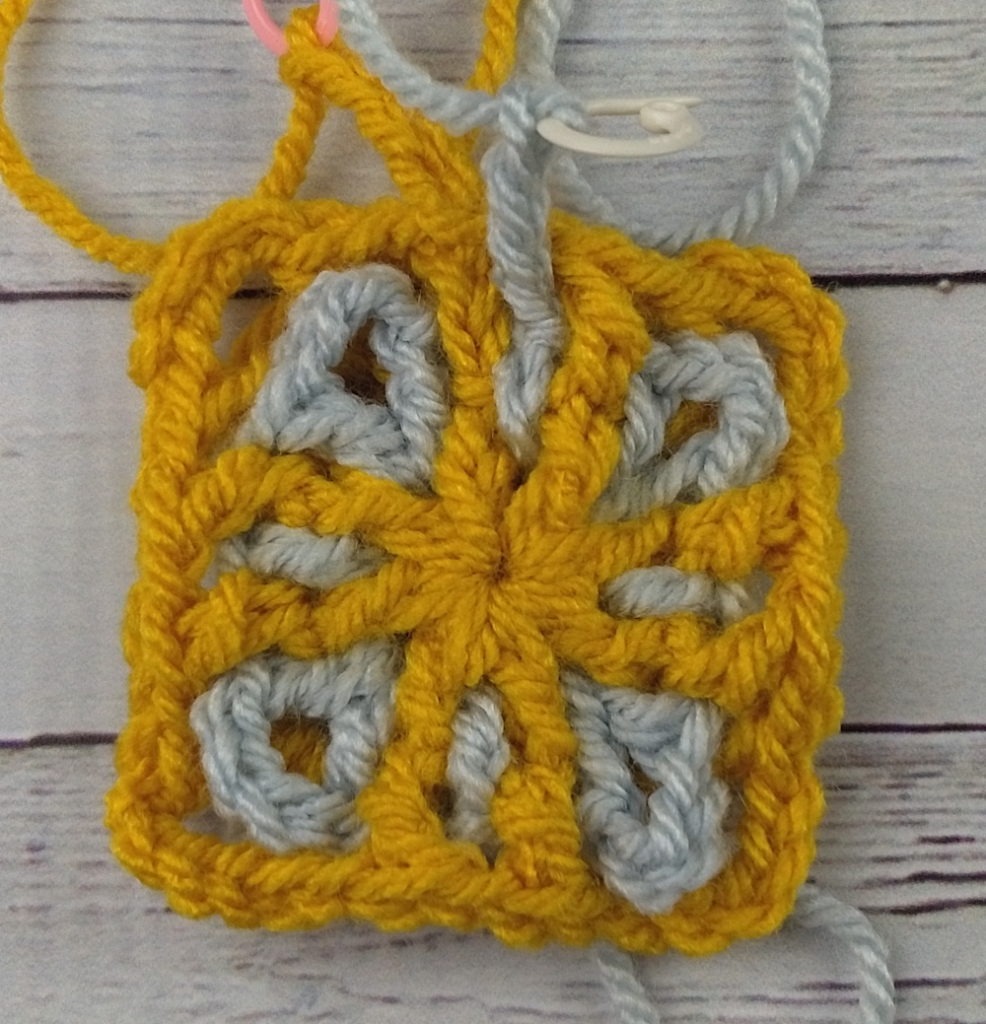
2B [Video 13:10]
[A in back] With B, bdc, bsplitc, fdc, bdc 2, bc, bdc, fdc, bdc, bsplitc, fdc, bdc 2, bc, bdc, join to 3rd st of starting ch. Ch4, place a stitch marker. (20dc)
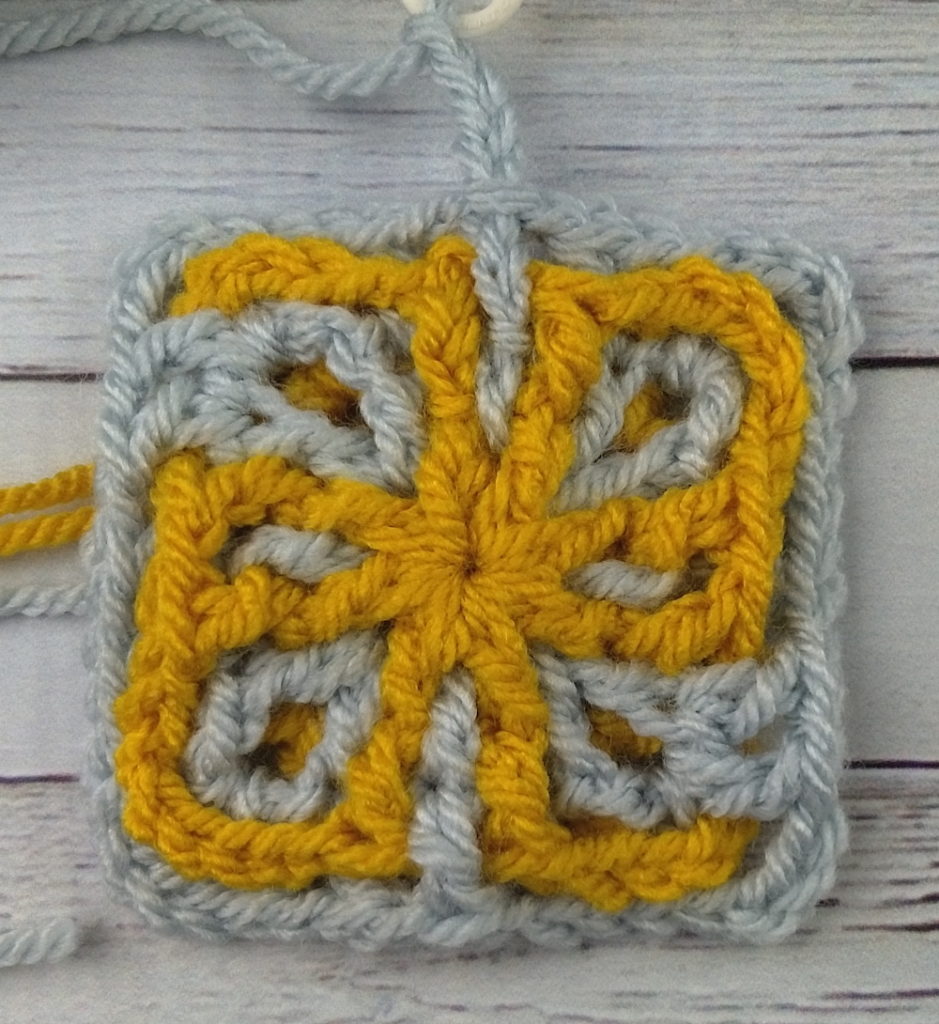
3A [Video 17:10]
[B in back] With A, bdc, bsplitc, bdc 2, fdc, bdc, bc, bdc 4, bsplitc, bdc 2, fdc, bdc, bc, bdc 2, join to 3rd st of starting ch. Ch4, place a stitch marker. (24dc)
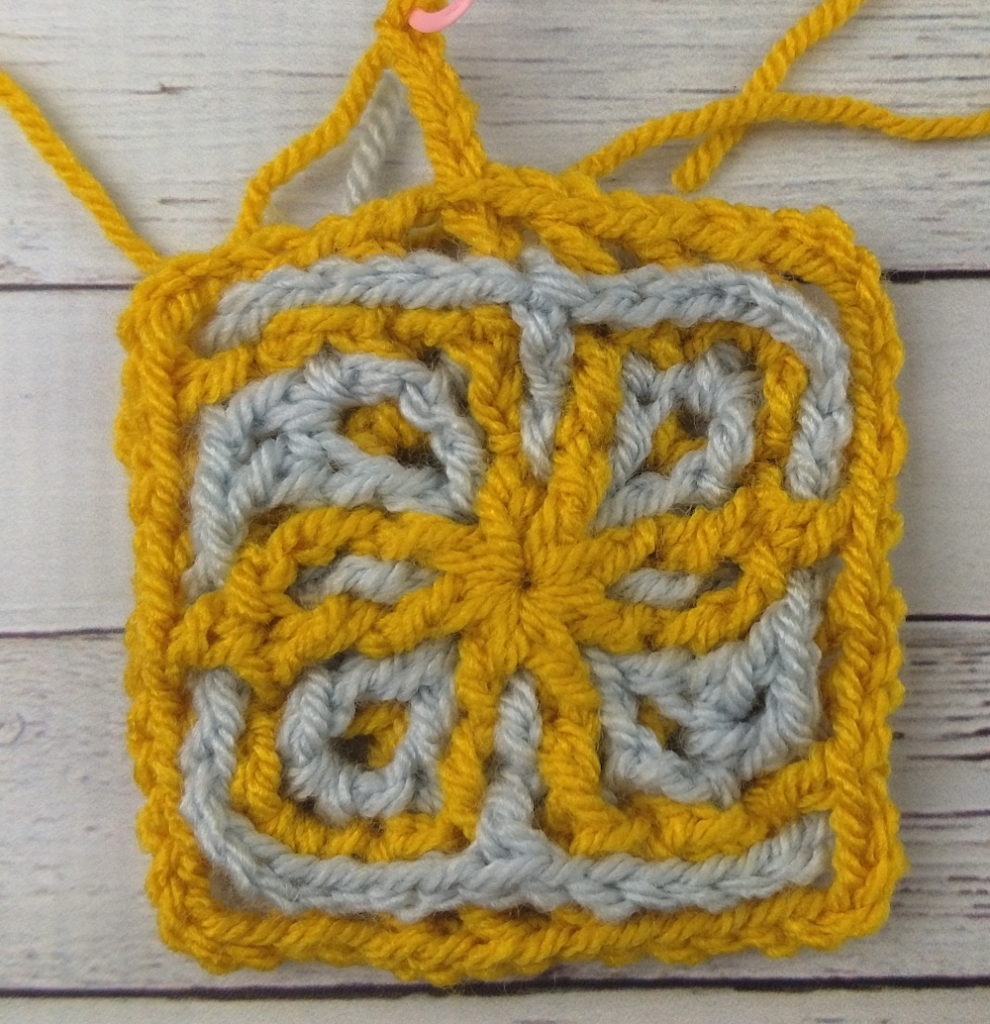
3B [Video 21:03]
[A in back] With B, bdc, fdc, fc, fdc 2, bdc 3, bsplitc, fdc, bdc 3, fdc, fc, fdc 2, bdc 3, bsplitc, fdc, bdc, join to 3rd st of starting ch. Ch4, place a stitch marker. (28dc)
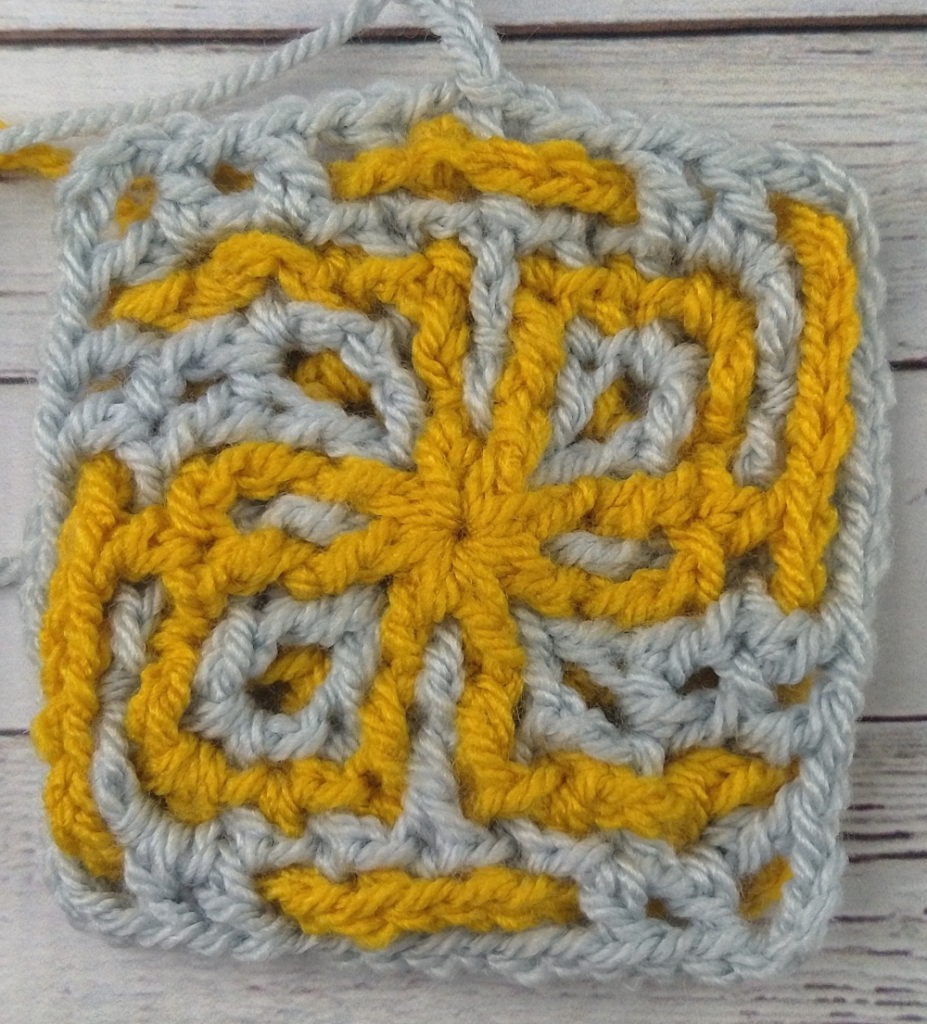
4A [Video 25:05]
[B in back] With A, fdc, bdc, bc, fdc, bdc, fdc 2, bdc 2, bsplitc, bdc, fdc, bdc 2, fdc, bdc, bc, fdc, bdc, fdc 2, bdc 2, bsplitc, bdc, fdc, bdc, join to 3rd st of starting ch. Ch4, place a stitch marker (32dc)
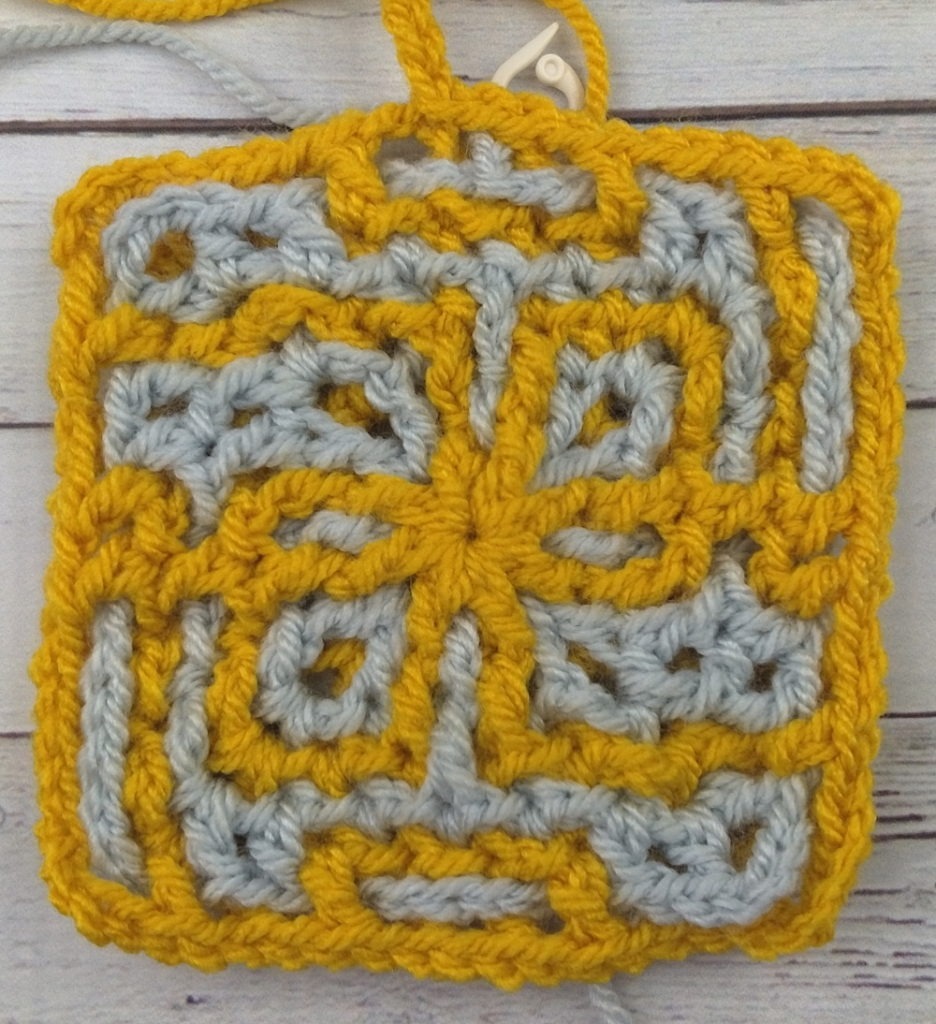
4B [Video 29:59]
[A in back] With B, bdc 2, fdc, fsplitc, fdc, bdc 3, fdc 3, fsplitc, bdc 6, fdc, fsplitc, fdc, bdc 3, fdc 3, fsplitc, bdc 3, join to 3rd st of starting ch. Ch4, place a stitch marker (36dc)
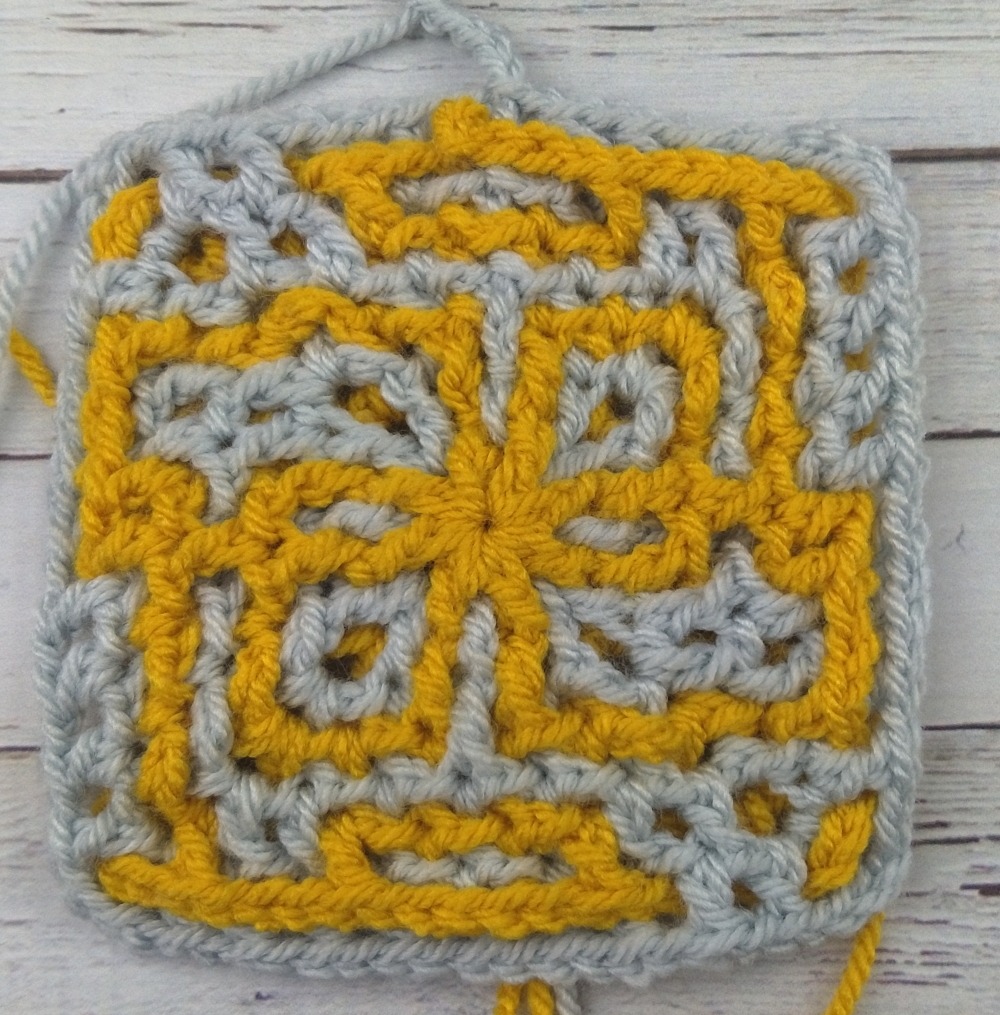
5A [Video 34:47]
[B in back] With A, fdc 2, bdc, fsplitc, fdc, bdc 2, fdc, bdc 4, fsplitc, fdc, bdc, fdc, bdc 2, fdc 2, bdc, fsplitc, fdc, bdc 2, fdc, bdc 4, fsplitc, (fdc, bdc) twice, join to 3rd st of starting ch. Ch4, place a stitch marker (40dc)
5B [Video 39:47]
[A in back] With B, bdc 2, fdc 2, bc (bdc 7, fdc 2, bc) three times, bdc 4, join to 3rd st of starting ch. Ch4, place a stitch marker (44dc)
6A [Video 45:16]
[B in front] With A, fdc, bdc 3, fc, bdc, fdc, (bdc 2, fdc) twice, bdc 2, bc, (bdc, fdc) twice, bdc 2, fdc, bdc 3, fc, bdc, fdc, (bdc 2, fdc) twice, bdc 2, bc, (bdc, fdc) twice, bdc, join to 3rd st of starting ch. Ch4, place a stitch marker (48dc)
6B [Video 51:16]
[A in back] With B, fdc 2, bdc 3, bsplitc, bdc 2, fdc 7, bdc, fdc, bc, bdc 2, fdc, bdc 2, fdc 3, bdc 3, bsplitc, bdc 2, fdc 7, bdc, fdc, bc, bdc 2, fdc, bdc 2, join to 3rd st of starting ch. Ch4, place a stitch marker (52dc)
7A [Video 58:05]
[B in front] With A, fdc 2, bdc 2, fdc, bsplitc, bdc 5, fdc, bdc 2, fdc 4, fc, bdc 3, fdc 3, bdc, fdc 2, bdc 2, fdc, bsplitc, bdc 5, fdc, bdc 2, fdc 4, fc, bdc 3, fdc 3, join to 3rd st of starting ch. Ch4, place a stitch marker (56dc)
7B [Video 1:04:33]
[A in front] With B, bdc 3, fdc 3, fc, fdc 3, bdc 2, fdc, bdc 7, fsplitc, bdc 2, fdc 5, bdc 3, fdc 3, fc, fdc 3, bdc 2, fdc, bdc 7, fsplitc, bdc 2, fdc 4, join to 3rd st of starting ch. Ch4, place a stitch marker (60dc)
8A [Video 1:11:30]
[B in back] With A, fdc 3, bdc, fdc, bdc, bc, fdc, bdc 2, fdc, bdc, fdc, bdc 3, fdc 4, bdc, bsplitc, (fdc, bdc) twice, fdc 7, bdc, fdc, bdc, bc, fdc, bdc 2, fdc, bdc, fdc, bdc 3, fdc 4, bdc, bsplitc, (fdc, bdc) twice, fdc 3, join to 3rd st of starting ch. Ch4, place a stitch marker (64dc)
8B [Video 1:18:14]
[A in front] With B, bdc, fdc, bdc 5, bc, bdc 10, fdc, bdc, fdc 3, fc, bdc 3, fdc 3, bdc 3, fdc, bdc 5, bc, bdc 10, fdc, bdc, fdc 3, fc, bdc 3, fdc 3, bdc, join to 3rd st of starting ch. Ch3, place a stitch marker (68dc)
9A [Video 1:25:57]
[B in front] With A, bdc 2, fdc, bdc, fdc, bdc 2, fc, bdc, fdc, bdc 2, fdc, bdc fdc, bdc 6, fdc, bdc 2, bc, bdc, fdc, bdc 3, fdc, bdc, fdc 2, bdc 2, fdc, bdc, fdc, bdc 2, fc, bdc, fdc, bdc 2, fdc, bdc, fdc, bdc 6, fdc, bdc 2, bc, bdc, fdc, bdc 3, fdc, bdc, fdc, join to 3rd st of starting ch. Tie off A color. (72dc)
9B [Video 1:33:52]
This row is the last row of the square (hooray!). At the end of row 8B you should have done a ch3 instead of a ch4. For this row, instead of making a chain between each double crochet, you are going to work blsc into the opposite color dc. So for this row, all dc’s are worked from the back into the B color dc below, and all blsc’s are worked into the A color dc below. This connects the two colors and makes a smooth edge!
Remember: For this row only, do not do a chain between stitches since you will be doing blsc instead.
Here’s row 9B: blsc, (bdc, blsc) three times, (fdc, blsc) twice, (bdc, blsc) three times. *To work corner – (fdc over B color chain, sc over A color chain) twice, fdc over B color chain once more. Continue along side – blsc, (bdc, blsc) twice, (fdc, blsc) three times, (bdc, blsc) twice, (fdc, blsc) seven times, (bdc, blsc) three times. To work corner – bdc over B color chain, blsc in second stitch of A color ch, bdc over B color chain, blsc in 4th stitch of A color ch, bdc over B color chain. Continue along side – blsc, (bdc, blsc) twice, (fdc, blsc) four times, (bdc, blsc) twice**, fdc, blsc, (bdc, blsc) three times, (fdc, blsc) twice, (bdc, blsc) three times. Repeat from * to ** once, join to top of starting ch, finish off and weave in ends.
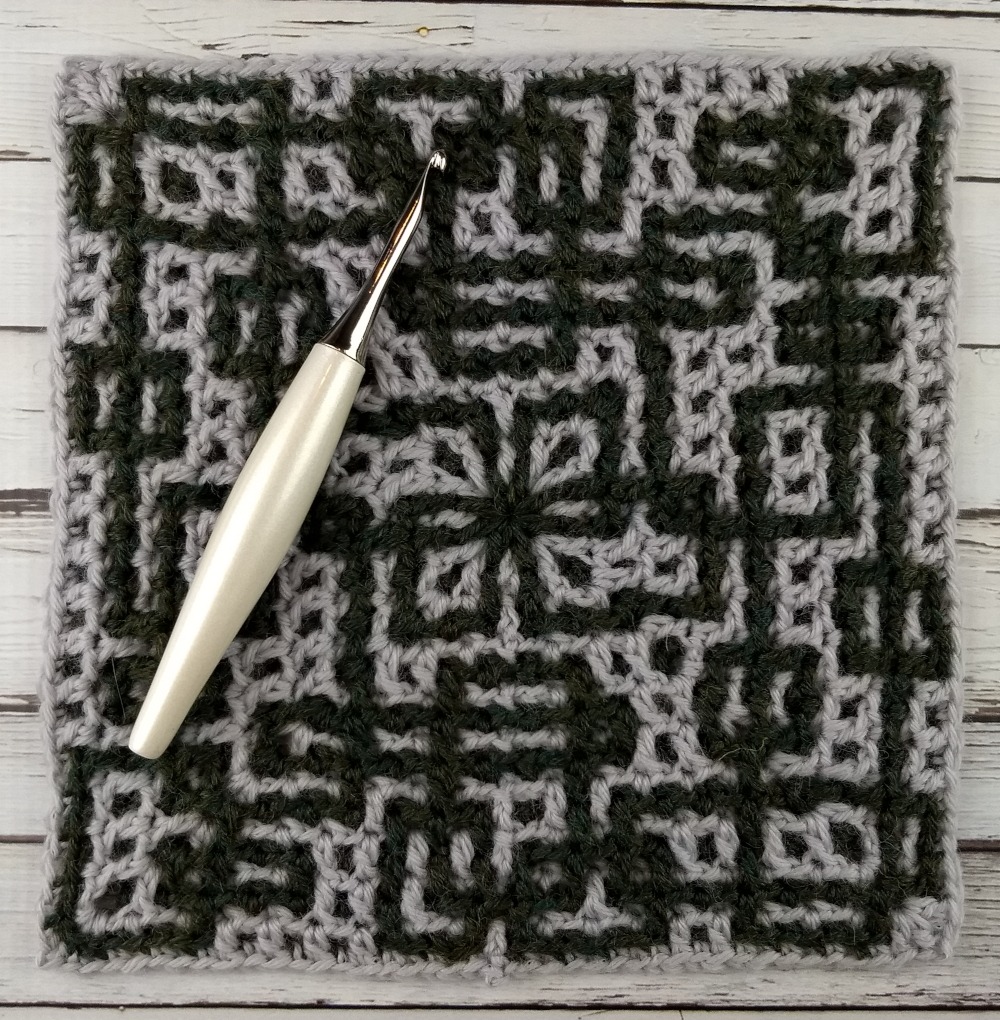
If you liked this interlocking crochet square pattern, you may also like the Cobblestone Scarf Pattern or the Zigzag Cowl. Stay tuned for the rest of the squares – subscribe to the email list below to get notified when the latest squares are released!
This pattern and all associated images are copyrighted. If you would like to use this pattern in a roundup blog post, you may use 1 image and link to this blog post. You may not copy the pattern instructions. Thank you for supporting Kickin Crochet!

In round 3A, there is an error after the second bsplitc, you have a fdc, which would give you too many stitches for the side. The video is correct.
Lol! I double checked this one carefully thinking no way is Nancy going to find something this month! Thank you again.
Will newsletter subscribers get a code to get this one free? If we already did I didn’t receive it
It will be in your email on Wednesday!